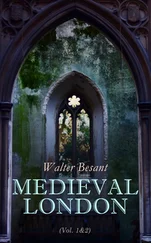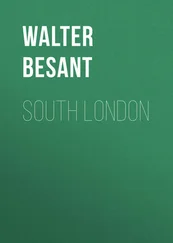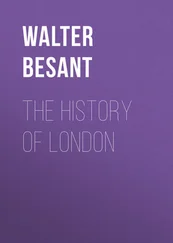Walter Besant - London
Здесь есть возможность читать онлайн «Walter Besant - London» — ознакомительный отрывок электронной книги совершенно бесплатно, а после прочтения отрывка купить полную версию. В некоторых случаях можно слушать аудио, скачать через торрент в формате fb2 и присутствует краткое содержание. Жанр: foreign_antique, foreign_prose, на английском языке. Описание произведения, (предисловие) а так же отзывы посетителей доступны на портале библиотеки ЛибКат.
- Название:London
- Автор:
- Жанр:
- Год:неизвестен
- ISBN:нет данных
- Рейтинг книги:4 / 5. Голосов: 1
-
Избранное:Добавить в избранное
- Отзывы:
-
Ваша оценка:
- 80
- 1
- 2
- 3
- 4
- 5
London: краткое содержание, описание и аннотация
Предлагаем к чтению аннотацию, описание, краткое содержание или предисловие (зависит от того, что написал сам автор книги «London»). Если вы не нашли необходимую информацию о книге — напишите в комментариях, мы постараемся отыскать её.
London — читать онлайн ознакомительный отрывок
Ниже представлен текст книги, разбитый по страницам. Система сохранения места последней прочитанной страницы, позволяет с удобством читать онлайн бесплатно книгу «London», без необходимости каждый раз заново искать на чём Вы остановились. Поставьте закладку, и сможете в любой момент перейти на страницу, на которой закончили чтение.
Интервал:
Закладка:
"Aurum mittit Arabs: species et thura Sabæus:
Arma Scythes: oleum palmarum divite sylva
Pingue solum Babylon: Nilus lapides pretiosos:
Norwegi, Russi, varium grisum, sabelinas:
Seres, purpureas vestes: Galli, sua vina."
The good cleric is a little mixed in his geography. The Arabs certainly had no gold to send; the Sabæans were, however, Arabs of Saba, in Arabia Felix: they sent myrrh and frankincense; spices came from another country. Why does he assign arms to the Scythians? Egypt had turquoise mines, but no other precious stones. The purple garments of the Seres, or Chinaman, are silks. Norway and Russia still send sables and other furs, and France, happily, still sends claret.
The city (Fitz Stephen adds), like Rome, is divided into wards, has annual sheriffs for its consuls, has senatorial and lower magistrates, sewers and aqueducts in its streets – its proper places and separate courts for cases of each kind, deliberative, demonstrative, judicial – and has assemblies on appointed days. I do not think there is a city with more commendable customs of church attendance, honor to God's ordinances, keeping sacred festivals, almsgiving, hospitality, confirming betrothals, contracting marriages, celebration of nuptials, preparing feasts, cheering the guests, and also in care for funerals and the interment of the dead. The only pests of London are the immoderate drinking of fools, and the frequency of fires. To this may be added that nearly all the Bishops, Abbots, and Magnates of England are, as it were, citizens and freemen of London, having their own splendid houses to which they resort, where they spend largely when summoned to great Councils by the King or by their Metropolitan, or drawn thither by their own private affairs.
A noble picture of a noble city!
Let us consider the monuments of the City. There remains of Saxon London nothing. Of Norman London, the great White Tower, the crypt of Bow, the crypt of St. John's Priory (outside the City), part of the church of Bartholomew the Great, part of St. Ethelburga's, Bishopsgate; there is nothing more. 2 2 See Loftie's History of London , Appendix N, "List of Buildings which existed before the Great Fire."
The cathedral of St. Paul's when Fitz Stephen wrote was slowly rising from its ashes. It had been already twice destroyed by fire. First, the church founded by Mellitus and beautified by Bishop Cedd and King Sebbi was burned to the ground in the year 961. We know nothing at all of this building or of its successor, which was destroyed in the year 1086. Bishop Maurice began to rebuild the church in the following year, but it was two hundred years before it was completed. This cathedral therefore belongs to a later period. That which was destroyed in 1084 must have resembled in its round arches and thick pillars the cathedral of Durham.
The church and the various buildings which belonged to it in the reign of Henry I. were surrounded by a wall. This wall included the whole area now known as St. Paul's Church-yard, and as far as Paternoster Row on the north side. There were six gates to the wall; the sites of two are preserved in the names of St. Paul's Alley and Paul's Chain. The Bishop's Palace was on the north-west corner; the chapter-house was on the south side of the church; on the north was a charnel-house and a chapel over it; close beside this was a small enclosure called Pardon Church-yard, where a chapel was founded by Gilbert à Becket, the saint's father. This enclosure was afterwards converted into a beautiful cloister, painted with a Dance of Death, called the Dance of St. Paul's. Close beside Pardon Church-yard was the chapel of Jesus, serving for the parish church of St. Faith until the chapel was destroyed, when the parish obtained the crypt for its church. St. Faith's is now coupled with St. Augustine's.
Of the thirteen large conventual churches mentioned by Fitz Stephen, we may draw up a tolerably complete list: St. Martin-le-Grand, St. Katherine's by the Tower, St. Mary Overies, Holy Trinity Priory, St. Bartholomew's Priory, St. Giles's Hospital, St. Mary of Bethlehem, the priory of St. John of Jerusalem, the nunnery afterwards turned into Elsing's Spital, the nunnery of St. John Baptist, Hollywell, the nunnery of Clerkenwell, the new Temple in Fleet Street, and the old Temple in Holborn, perhaps make up the thirteen. I cannot believe that Fitz Stephen could have included either Barking Abbey or Merton Abbey in his list.
The most ancient monastic foundation, next to that of St. Paul's, was St. Martin's House or College. Why St. Martin was so popular in this country, which had so many saints of her own, is not easily intelligible. Perhaps the story of the partition of the cloak at the gate of Amiens, while the saint was still a soldier, struck the imagination of the people. Certainly the saint's austerities at Ligujé would not attract the world. In London alone there were the church of St. Martin's, Ludgate Hill, said to have been founded in very early Saxon times, that of St. Martin's Outwich, of St. Martin Orgar, St. Martin Pomary, and St. Martin Vintry – five parish churches to attest his sanctity and his popularity.
St. Martin-le-Grand, sanctuary and collegiate church, was a Liberty to itself. Here criminals found safety and could not be arrested, a privilege which lasted long after the dissolution of the religious houses. Among the deans of St. Martin's was William of Wykeham.
One church only of the whole thirteen still stands. Part of the present church of St. Bartholomew the Great is that actually built by Rahere, the first founder, in the beginning of the twelfth century.
The story of Rahere is interesting but incomplete, and involved in many difficulties. He is variously said to have been the king's minstrel, the king's jester, a knight of good family, and a man of low origin, who haunted great men's tables and made them laugh – nothing less than the comic person of the period, entirely given over to the pleasures of the world. In short, the customary profligate, who presently saw the error of his ways, and was converted. The last statement is quite possible, because, as is well known, there was at this time a considerable revival of religion. The story goes on to say that, being penitent, Rahere went on a pilgrimage. Nothing more likely. At this time, going on pilgrimage offered attractions irresistible to many men. It was a most agreeable way of proving one's repentance, showing a contrite heart, and procuring absolution. It also enabled the penitent to see the world, and to get a beneficial change of air, food, and friends. There were dangers on the way: they lent excitement to the journey; robbers waylaid those of the pilgrims who had any money; fevers struck them low; if they marched through the lands of the infidel, they were often attacked and stripped, if not slain; the plains of Asia Minor were white with the bones of those cut off on their way to the Holy Land. But think of the joy, to one of an inquiring and curious mind who had never before been beyond sight of the gray old London walls, to be travelling in a country where everything was new – the speech, the food, the wine, the customs, the dress – with a goodly company, the length of the road beguiled by pleasant talk! Everybody pilgrimized who could, even the poorest and the lowest. The poorest could go as well as the richest, because the pilgrim wanted no money – he would start upon his tramp with an empty scrip. Such an one had naught to lose, and feared no robbers; he received bed and supper every night at some monastery, and was despatched in the morning after a solid breakfast. When he at length arrived at the shrine for which he was bound, he repeated the prayers ordered, performed the necessary crawlings, and heard the necessary masses; he then returned home, his soul purified, his sins forgiven, his salvation assured, and his memory charged with good stories for the rest of his life. The English pilgrim fared sometimes to Walsingham, sometimes to Canterbury, sometimes farther afield. He journeyed on foot through France and Italy to Rome; he even tramped all across Europe and Asia Minor, if he could be received in some great company guarded by the knights of St. John to the Holy Land. The roads in the eleventh and twelfth centuries were covered with pilgrims; the Mediterranean was black with ships going from Marseilles, from Genoa, from Naples, to the port of St. Jean d'Acre. Even the rustic, discovering that he, too, simple and unlettered as he was, had a soul to be saved, and that it would be better not to trust altogether to the last offices of the parish priest, threw down his spade, deserted his wife and his children, and went off on pilgrimage. At last the bishops interfered, and enjoined that no one should be considered and received as a pilgrim who could not produce an episcopal license. It was no longer enough for a man to get repentance in order to get the run of the road and of his teeth; and, since the episcopal license was not granted to everybody, the rustics had to fall back on what the parish church afforded, and have ever since been contented with her advice and authority.
Читать дальшеИнтервал:
Закладка:
Похожие книги на «London»
Представляем Вашему вниманию похожие книги на «London» списком для выбора. Мы отобрали схожую по названию и смыслу литературу в надежде предоставить читателям больше вариантов отыскать новые, интересные, ещё непрочитанные произведения.
Обсуждение, отзывы о книге «London» и просто собственные мнения читателей. Оставьте ваши комментарии, напишите, что Вы думаете о произведении, его смысле или главных героях. Укажите что конкретно понравилось, а что нет, и почему Вы так считаете.












